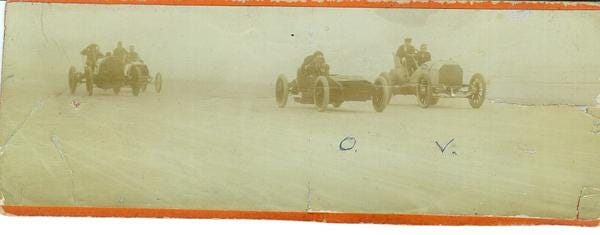Forgotten Pioneer of Auto Racing
Search
Featured Article
Image of The Week
Millionaire sportsman and racer-at-heart William K. Vanderbilt, Jr., aka “Willie K,” was born 140 years ago today. Don’t worry about the math, that was 1878.
Here’s the deal. Willie K was the 26-year-old scion of America’s wealthiest family when in 1904 he founded the country’s first major auto race, the Vanderbilt Cup. Willie K was a frequent visitor to the European Continent since childhood, networking even then with some of the most influential men in Society, such as Count Jules Albert de-Dion.
De-Dion was 21 years senior to Vanderbilt but because of his family’s wealth and influence, the Count embraced him as a teenager, acting as a mentor. Like most wealthy men of his age, he recognized the potential of individual mechanized transportation. He took the young man on road trips in the Alps, instructing him to feed the steam engine of this de-Dion automobile using a coal scuttle.
Vanderbilt was hooked and as a young man bought and sold cars, always looking for a faster machine. He ventured back to Europe and went racing with some strong results. In 1902 he finished third with his French Mors racer at the Circuit des Ardennes. This was against stiff competition from some of the world’s best drivers of the era — such as Charles Jarrott, Fernand Gabriel, and George Heath who was destined to win that first Vanderbilt Cup two years later.
Vanderbilt’s biggest single driving accomplishment came in January 1904 when he drove his 90 horsepower aluminum Mercedes to a land speed record of 92.3 mph on Ormond Beach, just north of Daytona. The image you see here was taken at that race meet, an annual gathering during the first decade of the 20th Century that was probably the second-most significant racing event of the year at the time.

Barney Oldfield (center) leads William K. Vanderbilt, Jr. Ormond Beach 1904
As for the photo, it shows Barney Oldfield in his Winton Bullet leading Vanderbilt in an event called, “the competition mile.” While Oldfield’s car at best produced as much as 10 horsepower less than the Mercedes and was of heavier wood and iron construction, the professional driver out-braved Vanderbilt by never lifting despite the random bumps or “washboards” on the natural speedway caused by the tide.
Trust me, this is, to coin a hackneyed phrase, just the tip of the iceberg. There are so many links to so much more information throughout First Super Speedway and beyond to the best sources of the Worldwide Web if you only click thru. But you have to step up and click, click, click!
